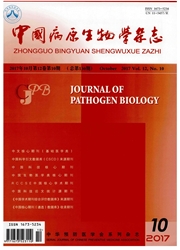

 中文摘要:
中文摘要:
目的研究开发有效的天然植物杀虫剂。方法按照WHO推荐的蚊幼虫敏感性测定方法,用8种植物的叶、茎、果和皮等提取物,对野生和敏感2个品系淡色库蚊进行敏感性测定。结果银杏外果皮提取物对淡色库蚊2个品系杀虫效果最强,其次为三尖杉和水杉,其他5种植物(重阳木、乌桕、香椿、杜仲和山茱萸)杀虫效果较弱。随后用银杏外果皮提取物对淡色库蚊卵、幼虫、蛹进行毒力测定,结果表明,Ⅰ龄幼虫最敏感,其次为Ⅱ龄、Ⅲ龄和Ⅳ龄幼虫。银杏外果皮提取物对敏感品系Ⅰ龄、Ⅱ龄、Ⅲ龄和Ⅳ龄的LC50分别为2.52、8.62、3.3和18.6mg/L;对野生品系Ⅰ龄、Ⅱ龄、Ⅲ龄和Ⅳ龄的LC50分别为7.4、15.2、19.2和25.0mg/L,明显高于敏感品系。银杏外果皮提取物在5~100mg/L浓度范围内不影响卵的孵化,在100mg/L以上时,影响蛹的羽化。结论8种植物提取物对淡色库蚊的敏感性各不相同,银杏外果皮提取物有明显的杀幼效果,值得进一步研究和开发。
 英文摘要:
英文摘要:
Objective To study effective and affordable natural insecticides. Methods The insecticidal activities of es- sential oil extracts from leaves, barks, fruits and exocarps of eight plants against the susceptible and field strains of the fourth instar larvae of the mosquito Cule.r pipiens pallens were determined by following the standard World Health Or- ganization larval susceptibility test methods. Results Extract of Ginkgo exocarps is the most toxic, followed by ex- tracts of Cephalotaxaceae and Metasequoia. Other five plants (Chinese Bishopwood , China Tallowtree , China Toona , Eucommia and Fructus Corni) have limited effect against these two strains of Cx. pipiens pallens. Toxicity of extract of Ginkgo exocarps to the eggs, larvae and pupae of the two strains of Cx. pipiens pallens was studied in succession. The most susceptible developmental stage of mosquito is the 1st instar, followed by the 2nd, 3rd and 4th instar. The LC50 values of the 1st, 2nd, 3rd, and 4th instar larvae in susceptible strains are 2.5, 8.6, 13.3 and 18.6 mg/L respectively. The LC50 value of each instar larvae of the field strain is higher than the susceptible strain. The LC50 values of the field strain were 7.4, 15.2, 19.2, and 25.0 mg/L for 1st through 4th instar larvae. The extract of Ginkgo exocarps has no ovicidal activity within 5--100 mg/L while the eclosion of pupae is affected by higher concentration (100 mg/L). Conclusion The insecticidal activities of extracts from the eight plant species may be different. The essential oil of Ginkgo exocarps has noticeable lavicidal property and its use as larvicide against mosquitoes should be explored, as this plant grows abun- dantly in China.
 同期刊论文项目
同期刊论文项目
 同项目期刊论文
同项目期刊论文
 期刊信息
期刊信息
